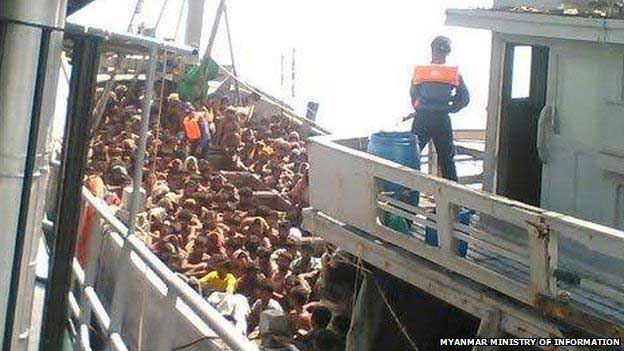
Myanmar (BBN)-Asian countries have agreed to work together to try to stem the region's migrant crisis, as Myanmar brought to shore another boat full of migrants.
Countries agreed to intensify search-and-rescue operations as well as address root causes of migration at a regional conference in Bangkok.
Myanmar rejected allegations that it is largely to blame for the crisis, reports BBC.
Myanmar's persecuted Rohingya minority as well as Bangladeshi immigrants make up the bulk of those stranded at sea.
On Friday it said it had picked up a boat with 727 migrants on board - just a week after it picked up about 200 in its first such operation.
The crisis began earlier this year when Thailand cracked down on overland migrant routes, forcing people smugglers to use sea routes instead.
Thousands of migrants are thought to be stranded at sea, trying to head south to Thailand, Indonesia and Malaysia.
At the start of the Asean regional grouping - also attended by the US, UN and International Organization for Migration (IOM) - Thai Foreign Minister Thanasak Patimaprakorn said the situation had reached "an alarming level".
'NO FINGER-POINTING'
Myanmar - also known as Burma - published images of the latest migrant vessel it says it intercepted off its southern coast on an official Facebook page.
They show a boat crammed with men, watched by a guard with a rifle. Below deck women are pictured - Myanmar says women and children account for 119 of those on board.
Myanmar said those picked up on Friday had been taken to a naval base in the Irrawaddy Delta.
It referred to the migrants as "Bengali" - a term it uses to describe immigrants from Bangladesh and its Rohingya Muslim minority.
The country has faced criticism for failing to do enough to help stranded migrants.
And in a speech at the start of the meeting, senior UN official Volker Turk alluded to Myanmar's harsh treatment of its effectively stateless Rohingya Muslims, saying "addressing root causes... requires full assumption of responsibility by Myanmar towards all people on its territory.
"In the interim, a legal status for all habitual residents recognising that Myanmar is their own country is urgently required."
But in Bangkok Myanmar foreign ministry chief Htin Linn hit back, telling delegates that on "this issue of illegal migration of boat people, you cannot single out my country.
"Finger-pointing will not serve any purpose. It will take us nowhere."
Friday's Asean meeting was attended by 17 countries affected by "irregular migration in the Indian Ocean", observers from the US, Japan and Switzerland and other agencies.
A FINAL STATEMENT SAID
Indonesia and Malaysia would continue to provide temporary shelter for migrants, provided that the international community would resettle or repatriate them within a year
Regional countries would intensify search-and-rescue efforts to ensure the safety of migrants
A joint task force would be established to co-ordinate assistance to countries dealing with migrants
Affordable and safe channels of legitimate migration would be enhanced
The US pledged $3m (£2m) to help the IOM deal with the crisis, while Australia pledged A$5m ($3.8; £2.5m) toward humanitarian assistance in Myanmar and Bangladesh
But many of these points were termed "proposals and recommendations", and it was not clear that full agreement to implement them had been reached.
The statement also said countries would address the root causes of irregular migration - working to create jobs and promoting "full respect for human rights and adequate access of people to basic rights and services such as housing, education and healthcare".
"The most encouraging result was the general consensus that these discussions need to continue," said IOM Director-General William Lacy Swing. "It cannot be a one-off."
ASIA'S MIGRANT CRISIS
Rohingya Muslims mainly live in Myanmar, where they have faced decades of persecution.
Rights groups say migrants feel they have "no choice" but to leave, paying people smugglers to help them.
The UN estimates more than 120,000 Rohingya have fled in the past three years.
Traffickers usually take the migrants by sea to Thailand then overland to Malaysia.
But Thailand recently began cracking down on the migrant routes, meaning traffickers are using sea routes instead.